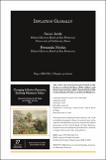Artículo
Inflation globally
Fecha
2020Resumen
The fortunes of the Phillips curve have ebbed and flowed ever
since it was proposed by Phillips (1958). Although its origins are
primarily as an empirical regularity, there is now a vast literature
that provides more formal justification. In recent times, the Great
Moderation and the modern era of central banking brought about
the apparent empirical demise of this core relationship. As central
banks gained credibility and inflation targeting became widespread,
inflation expectations became better anchored; however, the debate
is far from settled. Starting in the mid-1980s, several advanced
economies have generally experienced the business cycle with barely
a ripple in inflation. Paradoxically, a credible, inflation-targeting
central bank that cares about the tradeoff spelled by the Phillips
curve and sets policy to offset fluctuations in aggregate demand will
make empirical estimates of the Phillips curve appear flatter than
they really are. The Phillips curve is fundamental for a central bank
to evaluate counterfactual policy outcomes. It is not intended to be a
forecasting tool.
Colecciones
Descargar

El ítem tiene asociados los siguientes ficheros de licencia:

